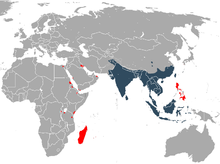Musk shrew
| Musk shrew | ||||||||||||
|---|---|---|---|---|---|---|---|---|---|---|---|---|

Musk shrew ( Suncus murinus ) |
||||||||||||
| Systematics | ||||||||||||
|
||||||||||||
| Scientific name | ||||||||||||
| Suncus murinus | ||||||||||||
| ( Linnaeus , 1766) |
The musk shrew , also known as the Asian house shrew ( Suncus murinus ), is a species of shrew from the genus of the thick-tailed shrew ( Suncus ). It is one of the largest and most widespread shrews.
features
With a head-to-trunk length of 11.9 to 14.7 centimeters and a weight of over 100 grams, the musk shrew is one of the largest species of shrew. The tail reaches a length of 6 to 8.5 centimeters and the hind foot from 1.9 to 2.2 centimeters. The coat consists of short and thick, ash-gray hair, and the back color varies from black-gray and brown-gray to blue-gray, the belly side is slightly lighter. The thick tail, which is covered with numerous bristly hairs, is striking. The muzzle is long with forward-pointing, soft vibrissae . The ears are bare and look noticeably wrinkled.
Fragrance glands surrounded by bristles on the flanks give off a secretion that smells strongly of musk, especially during the mating season .
distribution
Musk shrews originally lived in the Indomalayan region of South , East, and Southeast Asia , but were introduced to many other areas by humans. Today the species also lives in northern and eastern Africa including Madagascar , in the Middle East , on previously unpopulated islands in the Philippines and on the island of Guam .
Way of life
These animals occur both in the wild and as cultural followers , so they are often found in the vicinity of humans. The animals living close to humans can be found in storehouses and in agricultural areas. In the wild, the animals live in habitats with sparse vegetation in bushes and forests. They prefer humid habitats around swamps and ponds. Musk shrews spend the day sleeping in buildings or houses and go looking for food at night. They are loners who react aggressively to their own species and communicate with high-pitched chirping and humming noises. The food mainly consists of insects such as crickets, cockroaches and flies, but as omnivores they often also eat bread, flour and other human foods. They rarely attack and prey on larger animals such as frogs and snakes up to a length of 46 centimeters.
Mating can occur all year round, the females can become pregnant twice a year. There are two breeding seasons in southern China: one before the monsoons in April to June and one at the end of the monsoon in August to October. After about four weeks of gestation, one to five, on average three to four young animals are born. These are weaned at three weeks and then stay with their parents for another three weeks; they are fully grown after five weeks. Their life expectancy is 1.5 to 2.5 years.
Systematics
The musk shrew is classified as an independent species within the thick-tailed shrew (genus Suncus ). The first scientific description comes from Carl von Linné in 1766.
Apart from the nominate form, no further subspecies are distinguished within the species .
The only European owner is Pilsen, former German owners are Berlin, Leipzig and Kleve.
Threat and protection
The species is classified by the International Union for Conservation of Nature and Natural Resources (IUCN) as not endangered (“least concern”) due to its large distribution area and the assumed large population numbers. It occurs in several protected areas and as a commensal of humans is very adaptable in terms of habitat.
literature
- Robert S. Hoffmann, Darrin Lunde: Asian House Shrew. In: Andrew T. Smith , Yan Xie: A Guide to the Mammals of China. Princeton University Press, Princeton NJ 2008, ISBN 978-0-691-09984-2 , p. 303.
supporting documents
- ↑ a b c d e f Robert S. Hoffmann, Darrin Lunde: Asian House Shrew. In: Andrew T. Smith , Yan Xie: A Guide to the Mammals of China. Princeton University Press, Princeton NJ 2008, ISBN 978-0-691-09984-2 , p. 303.
- ↑ a b c Suncus murinus in the IUCN Red List of Threatened Species 2012.2. Listed by: R. Hutterer, S. Molur, L. Heaney, 2008. Retrieved May 23, 2013.
- ↑ a b c Suncus murinus ( Memento of the original from November 10, 2013 in the Internet Archive ) Info: The archive link was automatically inserted and not yet checked. Please check the original and archive link according to the instructions and then remove this notice. . In: Don E. Wilson , DeeAnn M. Reeder (Eds.): Mammal Species of the World. A taxonomic and geographic Reference. 2 volumes. 3. Edition. Johns Hopkins University Press, Baltimore MD 2005, ISBN 0-8018-8221-4 .
- ↑ [1] ZTL 11.6.
Web links
- Suncus murinus inthe IUCN 2012 Red List of Threatened Species . 2. Listed by: R. Hutterer, S. Molur, L. Heaney, 2008. Retrieved May 23, 2013.


